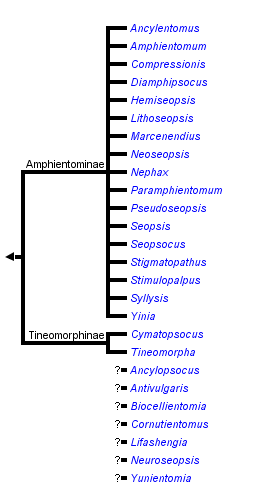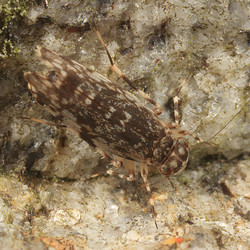Amphientomidae
Emilie Bess and Kevin P. Johnson


This tree diagram shows the relationships between several groups of organisms.
The root of the current tree connects the organisms featured in this tree to their containing group and the rest of the Tree of Life. The basal branching point in the tree represents the ancestor of the other groups in the tree. This ancestor diversified over time into several descendent subgroups, which are represented as internal nodes and terminal taxa to the right.

You can click on the root to travel down the Tree of Life all the way to the root of all Life, and you can click on the names of descendent subgroups to travel up the Tree of Life all the way to individual species.
For more information on ToL tree formatting, please see Interpreting the Tree or Classification. To learn more about phylogenetic trees, please visit our Phylogenetic Biology pages.
close boxIntroduction
Amphientomidae contains 20 genera and about 100 species distributed worldwide with the greatest diversity in Africa and Asia. Three species in the genera Lithoseopsis and Stimulopalpus are found in North America.
Amphientomids have scales covering their bodies and wings. They are found on the surfaces of rocks, often near water.
Characteristics
- Body and wings covered with scales (often lost if insect is preserved in liquid).
- Head:
- Antennae have 15 segments.
- Antennal segments are sculptured with narrow rings (annulations).
- Ocelli are not in groups.
- Legs: Tarsi have 3 segments.
- Wings: Wings are covered with scales (often lost if insect is preserved in liquid).
- Forewings:
- Pterostigma not thickened
- Veins 1A and 2A end separately on the wing margin.
- Forewing has two anal veins.
- Male:
- Phallosome is open posteriorly.
- Parameres arise from a plate in the median anterior area of the phallosome.
- Female:
- Subgenital plate usually has a T-shaped or wedge-shaped sclerite.
- Gonapophyses are complete; the external valve has two lobes.
- Eggs: Eggs are smooth and encrusted with debris.
Discussion of Phylogenetic Relationships
Molecular analysis including three species of Amphientomidae does not support the monophyly of the family, but places it in a group with families Troctopsocidae and Musaposicdae (18S nDNA; Johnson et al. 2004). Further study will be necessary to resolve the relationships among these families.
References
Johnson, K. P., K. Yoshizawa, and V. S. Smith. 2004. Multiple origins of parasitism in lice. Proceedings of the Royal Society of London B 271:1771-1776.
Lienhard, C. and C.N. Smithers. 2002. Psocoptera (Insecta) World Catalogue and Bibliography. Muséum d'Histoire Naturelle, Geneva, Switzerland.
Mockford, E.L. 1967. The Electrentomoid Psocids (Psocoptera). Psyche 74: 118-165.
Mockford, E. L. 1993. North American Psocoptera (Insecta). Gainesville, Florida: Sandhill Crane Press.
Smithers, C.N. 1972. The classification and phylogeny of the Psocoptera. Memoirs of the Australian Museum 14: 1–349.
Title Illustrations

| Scientific Name | Stimulopalpus japonicus |
|---|---|
| Location | Harvard, Ma. |
| Comments | 10/4/2008 |
| Specimen Condition | Live Specimen |
| Life Cycle Stage | adult |
| View | dorsal |
| Copyright | © Tom Murray |
About This Page
Emilie Bess

Illinois Natural History Survey, Champaign, Illinois, USA
Kevin P. Johnson

Illinois Natural History Survey, Champaign, Illinois, USA
Correspondence regarding this page should be directed to Emilie Bess at and Kevin P. Johnson at
Page copyright © 2009 Emilie Bess and Kevin P. Johnson
All Rights Reserved.
- First online 25 March 2009
- Content changed 25 March 2009
Citing this page:
Bess, Emilie and Kevin P. Johnson. 2009. Amphientomidae. Version 25 March 2009 (under construction). http://tolweb.org/Amphientomidae/14458/2009.03.25 in The Tree of Life Web Project, http://tolweb.org/







 Go to quick links
Go to quick search
Go to navigation for this section of the ToL site
Go to detailed links for the ToL site
Go to quick links
Go to quick search
Go to navigation for this section of the ToL site
Go to detailed links for the ToL site